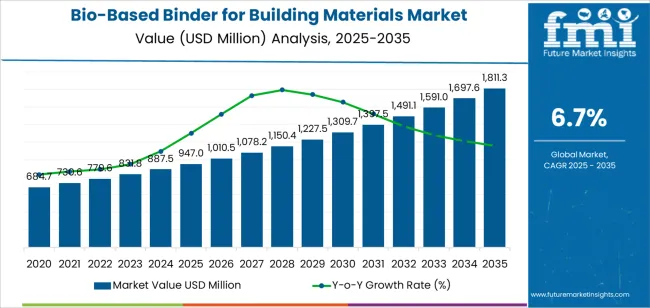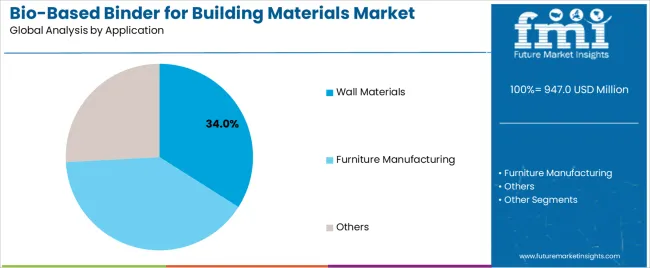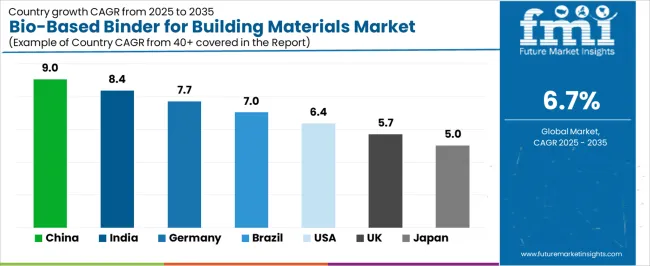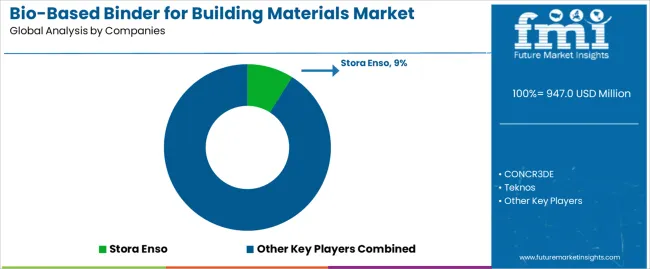The bio-based binder for building materials market is valued at USD 947.0 million in 2025. Demand is projected to reach USD 1,811.3 million by 2035, representing a compound annual growth rate of 6.7% and an absolute dollar opportunity of USD 864.3 million over the forecast period. Growth is being driven by demand for renewable feedstock binders derived from starch, lignin and plant resins, with a low Growth Rate Volatility Index of 0.20 indicating steady expansion. The starch-based classification is the leading product category, accounting for about 28% of sales in 2025, while wall materials comprise the largest application, at approximately 34%, as builders and manufacturers seek low-VOC adhesive solutions and improved life-cycle performance.
Europe, Asia Pacific and North America remain the principal regions of consumption, with China, India and Germany recording the highest country-level CAGRs at 9.0%, 8.4% and 7.7% respectively. Advances in biopolymer modification shape market dynamics, hybrid binder formulations that combine renewable content with performance enhancers, and the scale-up of production capacity to reduce unit costs. Constraints include higher raw material and processing costs, integration challenges with existing manufacturing lines, and limited long-term field data for some novel chemistries.

Europe remains the leading region due to well-established green building initiatives and material certification standards. North America is experiencing consistent growth, driven by policy support for energy-efficient building design. Asia Pacific continues to emerge as a fast-growing market supported by urban development projects and increasing investment in sustainable infrastructure. Through 2035, advancements in biopolymer modification, supply chain efficiency, and production scalability are expected to sustain the market’s upward trend.
Between 2025 and 2030, the Bio-Based Binder for Building Materials Market is projected to grow from USD 947.0 million to USD 1,309.7 million, marking an acceleration phase with a 38.3% increase over the first five years. This period represents the most dynamic stage of market expansion, driven by escalating demand for sustainable construction materials and stricter environmental regulations on volatile organic compounds (VOCs). Construction firms are increasingly adopting bio-based binders derived from renewable sources such as lignin, starch, and vegetable oils, thereby reducing carbon emissions and improving indoor air quality. Additionally, government-led green building initiatives and certification programs such as LEED and BREEAM are accelerating adoption across the residential and commercial sectors.
From 2030 to 2035, the market is expected to expand from USD 1,309.7 million to USD 1,811.3 million, reflecting a deceleration phase with a 38.3% increase as the industry moves toward maturity and standardization. Growth during this period will be supported by widespread acceptance of bio-based construction materials and advancements in hybrid binder formulations that combine renewable polymers with performance-enhancing additives. Manufacturers will focus on improving cost efficiency, production scalability, and long-term durability. Market activity will also shift toward retrofitting and renovation projects aligned with circular-economy principles, emphasizing recyclable materials and low-embodied-carbon construction practices.
| Metric | Value |
|---|---|
| Market Value (2025) | USD 947.0 million |
| Market Forecast Value (2035) | USD 1,811.3 million |
| Forecast CAGR (2025–2035) | 6.7% |
The bio-based binder for building materials market is expanding as the construction industry transitions toward environmentally responsible formulations that reduce reliance on petrochemical-derived adhesives and cements. Bio-based binders, developed from natural polymers such as lignin, starch, soy protein, and plant oils, serve as bonding agents in insulation boards, wall panels, coatings, and composite structures. These materials lower carbon emissions, improve indoor air quality, and align with green certification standards such as LEED and BREEAM. Manufacturers focus on enhancing water resistance, curing strength, and compatibility with mineral aggregates to ensure structural stability comparable to conventional synthetic binders.
Market growth is supported by stricter environmental regulations and increasing investment in sustainable infrastructure projects across Europe, North America, and parts of Asia. Government incentives promoting renewable construction inputs and corporate sustainability commitments accelerate adoption among developers and material producers. Research initiatives in polymer chemistry and biorefinery processes continue to expand the performance capabilities of next-generation bio-binders, making them suitable for high-stress construction applications. Although production costs and scalability challenges remain, technological advances in enzymatic processing and crosslinking modification are improving economic viability. Rising awareness of lifecycle emissions and circular building practices ensures steady long-term demand for bio-based binders in global construction markets.
The bio-based binder for building materials market is segmented by classification, application, and region. By classification, the market is divided into starch-based, protein-based, and others. Based on application, it is categorized into wall materials, furniture manufacturing, and others. Regionally, the market is segmented into North America, Europe, East Asia, South Asia, Latin America, and the Middle East & Africa. These segments capture variations in renewable material utilization, application diversity, and regional construction practices influencing bio-based binder adoption across the global building materials industry.

The starch-based segment accounts for approximately 28.0% of the global bio-based binder for building materials market in 2025, representing the leading classification category. Its prominence is driven by starch’s availability, biodegradability, and strong adhesive properties, which make it suitable for bonding fibrous and composite building materials. Derived from renewable agricultural feedstocks such as corn and potatoes, starch-based binders support sustainable construction by reducing dependency on petroleum-derived adhesives.
These binders are commonly used in lightweight wall panels, insulation boards, and interior coatings, where moderate water resistance and bonding strength are sufficient. Advances in chemical modification techniques have improved starch binder durability and performance under variable temperature and humidity conditions. The segment’s adoption is particularly strong in Europe and East Asia, where green building standards and eco-label certification programs promote the use of renewable materials in construction. Manufacturers continue to develop hybrid formulations that combine starch with natural resins to enhance mechanical integrity and long-term stability. The starch-based category remains central to the market due to its cost efficiency, low carbon footprint, and compatibility with diverse building material substrates in sustainable construction practices.

The wall materials segment represents about 34.0% of the total bio-based binder for building materials market in 2025, making it the largest application category. This dominance is linked to the growing integration of eco-friendly adhesives in wallboards, plasters, and composite wall systems used across residential and commercial construction projects. Bio-based binders offer a renewable alternative to synthetic resins, supporting emissions reduction and improved indoor air quality by limiting volatile organic compound (VOC) release.
The segment’s demand is reinforced by policy-driven sustainability initiatives encouraging the use of renewable components in green buildings. In Europe and North America, construction standards increasingly emphasize material transparency and life-cycle sustainability, creating consistent demand for bio-based wall bonding agents. Starch- and protein-based binders are favored for their strong adhesion to mineral and fibrous surfaces, as well as their compatibility with natural fillers and coatings. Manufacturers are also focusing on improving water resistance and curing properties to enhance structural integrity. The wall materials segment continues to dominate market demand as sustainable building practices expand globally, positioning bio-based binders as essential components in environmentally responsible construction systems and interior finishing applications.
The market for bio-based binders used in building materials is expanding as the construction sector intensifies its focus on sustainability and low-carbon alternatives. These binders, derived from renewable resources such as lignin, plant starches and bio-oils, serve as adhesive or binding agents in composites, insulation boards, panels and structural elements. Growth is fueled by green-building standards and rising demand for eco-friendly construction materials. However, higher costs, performance uncertainties compared with traditional binders, and supply-chain constraints temper adoption. Suppliers are responding with custom formulations, improved processing compatibility and partnerships with building-material manufacturers.
Increased regulatory pressure aimed at reducing embodied carbon and VOC emissions in building materials is motivating manufacturers to adopt bio-based binders. For building-material producers seeking compliance and certification (e.g., LEED, BREEAM), a unique USP lies in "renewable-feedstock binder solutions certified for reduced-emission construction systems" enabling these producers to meet sustainability targets and appeal to eco-conscious clients. Growth in the retrofit and new-build sectors further expands the demand for binders compatible with modern eco-material strategies.
Wider market uptake is constrained by factors including higher raw-material and production costs, potential performance variability under certain conditions, and limited long-term service data. Some building-material manufacturers may hesitate to switch from established synthetic binder systems due to concerns over durability, curing times or integration with existing processes. For binder suppliers targeting this segment, a compelling USP is "rapid on-site trial support and custom-formulation services that align with existing production lines and minimise change-over risk," which helps reduce the barrier to adoption for manufacturers adopting new binder technologies.
Key trends include development of hybrid binder systems combining bio-based and conventional chemistries, modular binder platforms tailored for different building substrates (e.g., insulation boards, panels, composites) and enhanced digital formulation tools that optimise performance for specific applications. For building-material manufacturers, a relevant USP is "platformised binder portfolio with interchangeable bio-feedstock ratios and application-specific modules, enabling scalable deployment across multiple product lines," thereby supporting efficiency and material diversification across construction materials portfolios.

| Country | CAGR (%) |
|---|---|
| China | 9.0% |
| India | 8.4% |
| Germany | 7.7% |
| Brazil | 7.0% |
| USA | 6.4% |
| UK | 5.7% |
| Japan | 5.0% |
The Bio-Based Binder for Building Materials Market is advancing rapidly worldwide, with China leading at a 9.0% CAGR through 2035, driven by government sustainability mandates, expanding green construction projects, and rapid adoption of eco-friendly material technologies. India follows at 8.4%, supported by infrastructure expansion, the rise of sustainable construction standards, and strong domestic biopolymer production.
Germany records 7.7%, reflecting leadership in bio-based chemistry, advanced R&D initiatives, and energy-efficient building practices. Brazil grows at 7.0%, benefitting from abundant biomass resources and increasing investment in sustainable construction materials. The USA, at 6.4%, emphasizes innovation in low-carbon and recyclable binders, while the UK (5.7%) and Japan (5.0%) focus on material optimization, environmental certifications, and integration of circular economy principles in modern construction applications.
China is recording strong progress in the bio-based binder for building materials market, projected to grow at a CAGR of 9.0% through 2035. Rapid urban development combined with government-led sustainability programs is boosting demand for renewable construction materials. Domestic producers are expanding output of starch, lignin, and protein-based binders that enhance adhesion and reduce carbon emissions. Growing adoption of low-VOC construction adhesives across residential and commercial projects supports consistent market expansion. Collaboration between universities and chemical firms continues to enhance process efficiency and product performance.
India is witnessing rapid development in the bio-based binder for building materials market, expanding at a CAGR of 8.4%, supported by green building initiatives and rising interest in renewable construction technologies. Local manufacturers are producing bio-resin systems from agricultural waste such as rice husk and sugarcane fiber. The country’s expanding infrastructure projects and smart city programs continue to encourage bio-based adoption. Focus on cost-effective binder production and regional sourcing strategies improves accessibility for both small and large construction contractors.
Across Germany, the bio-based binder for building materials market is advancing at a CAGR of 7.7%, supported by the country’s leadership in polymer chemistry and environmentally compliant construction. Manufacturers are developing next-generation bio-binders using lignocellulosic and starch-derived polymers for concrete, coatings, and insulation materials. Strong R&D collaboration between industry and academia is improving binder durability and moisture resistance. Compliance with EU sustainability targets and energy-efficient building standards continues to drive adoption across the commercial construction sector.
Brazil is recording steady progress in the bio-based binder for building materials market, forecast to expand at a CAGR of 7.0% through 2035. Increasing awareness of green construction methods and sustainable adhesives is promoting adoption among local developers. Manufacturers are focusing on producing soy-based and plant-derived binders suited for tropical climates. Government incentives supporting renewable material use in infrastructure projects contribute to steady consumption. Growth in housing and commercial renovations continues to reinforce long-term demand.

In the United States, the bio-based binder for building materials market is growing at a CAGR of 6.4%, supported by federal sustainability policies and advancements in green chemistry. Producers are developing renewable adhesive systems for flooring, insulation, and panel bonding applications. Expansion in LEED-certified and net-zero construction projects is driving increased adoption. Ongoing technological innovation in biopolymer formulation and performance testing continues to align with the country’s energy-efficient building objectives.
Across the United Kingdom, the bio-based binder for building materials market is advancing at a CAGR of 5.7%, driven by expanding adoption of eco-design principles and sustainable construction frameworks. Manufacturers are investing in recyclable and biodegradable polymer formulations for use in interior and exterior applications. The increasing alignment of domestic standards with European green building directives supports steady adoption. Urban redevelopment projects emphasizing reduced carbon footprints continue to encourage large-scale material replacement.
Japan is showing consistent advancement in the bio-based binder for building materials market, projected to grow at a CAGR of 5.0% through 2035. Domestic companies emphasize molecular precision and hybrid formulations combining natural polymers with synthetic stabilizers for improved strength. Bio-based binders are being applied in flooring, insulation, and architectural coatings, reflecting the country’s focus on high-quality, low-emission materials. Continuous research into bio-derived adhesives supports stable production and export growth within the Asia-Pacific construction sector.

The global bio-based binder for building materials market shows moderate concentration, driven by chemical innovators and construction material manufacturers adopting renewable alternatives to conventional petrochemical binders. Stora Enso leads the market with an estimated 9% share, supported by its lignin-based binders designed for wood composites, insulation materials, and sustainable concrete formulations. CONCR3DE and Teknos focus on additive manufacturing and coatings applications, emphasizing bio-derived resins that enhance adhesion and structural durability.
BASF and Trinseo maintain strong positions through large-scale chemical expertise, developing hybrid polymer systems that combine renewable content with consistent mechanical strength. Cargill and Lumiforte contribute through bio-polyol and starch-based binders tailored for paints, sealants, and construction composites with improved carbon performance.
Dow and Ventraco integrate renewable chemistry into building material solutions, emphasizing scalability and compatibility with existing production infrastructure. BIOBUILD advances innovation through research-driven initiatives linking material science with circular construction objectives. Knauf applies bio-based binders within gypsum and insulation systems, aligning with sustainable building certifications. Competition across this market is influenced by tensile performance, curing time, and compatibility with mineral and cellulose-based substrates.
Strategic differentiation depends on binder stability, renewable content optimization, and compliance with green building standards such as LEED and BREEAM. Long-term competitiveness relies on cost parity with traditional binders, material durability under varying environmental conditions, and industrial-scale adoption supporting the transition toward low-carbon construction ecosystems.
| Items | Values |
|---|---|
| Quantitative Units (2025) | USD million |
| Type (Classification) | Starch-Based, Protein-Based, Others |
| Application | Wall Materials, Furniture Manufacturing, Others |
| End User | Building Material Manufacturers, Construction Contractors, Interior Product Suppliers, Green Building Developers |
| Regions Covered | North America, Europe, East Asia, South Asia, Latin America, Middle East & Africa, Eastern Europe |
| Countries Covered | China, India, USA, Germany, Brazil, UK, Japan, and 40+ countries |
| Key Companies Profiled | Stora Enso, CONCR3DE, Teknos, BASF, Trinseo, Cargill, Lumiforte, Dow, Ventraco, BIOBUILD, Knauf |
| Additional Attributes | Dollar sales by type and application categories; regional adoption trends across green construction markets; competitive landscape emphasizing binder innovation and eco-certification alignment. |
The global bio-based binder for building materials market is estimated to be valued at USD 947.0 million in 2025.
The market size for the bio-based binder for building materials market is projected to reach USD 1,811.3 million by 2035.
The bio-based binder for building materials market is expected to grow at a 6.7% CAGR between 2025 and 2035.
The key product types in bio-based binder for building materials market are starch-based, protein-based and others.
In terms of application, wall materials segment to command 34.0% share in the bio-based binder for building materials market in 2025.






Our Research Products

The "Full Research Suite" delivers actionable market intel, deep dives on markets or technologies, so clients act faster, cut risk, and unlock growth.

The Leaderboard benchmarks and ranks top vendors, classifying them as Established Leaders, Leading Challengers, or Disruptors & Challengers.

Locates where complements amplify value and substitutes erode it, forecasting net impact by horizon

We deliver granular, decision-grade intel: market sizing, 5-year forecasts, pricing, adoption, usage, revenue, and operational KPIs—plus competitor tracking, regulation, and value chains—across 60 countries broadly.

Spot the shifts before they hit your P&L. We track inflection points, adoption curves, pricing moves, and ecosystem plays to show where demand is heading, why it is changing, and what to do next across high-growth markets and disruptive tech

Real-time reads of user behavior. We track shifting priorities, perceptions of today’s and next-gen services, and provider experience, then pace how fast tech moves from trial to adoption, blending buyer, consumer, and channel inputs with social signals (#WhySwitch, #UX).

Partner with our analyst team to build a custom report designed around your business priorities. From analysing market trends to assessing competitors or crafting bespoke datasets, we tailor insights to your needs.
Supplier Intelligence
Discovery & Profiling
Capacity & Footprint
Performance & Risk
Compliance & Governance
Commercial Readiness
Who Supplies Whom
Scorecards & Shortlists
Playbooks & Docs
Category Intelligence
Definition & Scope
Demand & Use Cases
Cost Drivers
Market Structure
Supply Chain Map
Trade & Policy
Operating Norms
Deliverables
Buyer Intelligence
Account Basics
Spend & Scope
Procurement Model
Vendor Requirements
Terms & Policies
Entry Strategy
Pain Points & Triggers
Outputs
Pricing Analysis
Benchmarks
Trends
Should-Cost
Indexation
Landed Cost
Commercial Terms
Deliverables
Brand Analysis
Positioning & Value Prop
Share & Presence
Customer Evidence
Go-to-Market
Digital & Reputation
Compliance & Trust
KPIs & Gaps
Outputs
Full Research Suite comprises of:
Market outlook & trends analysis
Interviews & case studies
Strategic recommendations
Vendor profiles & capabilities analysis
5-year forecasts
8 regions and 60+ country-level data splits
Market segment data splits
12 months of continuous data updates
DELIVERED AS:
PDF EXCEL ONLINE
Bio-Based Building Materials Market Size and Share Forecast Outlook 2025 to 2035
Binders Market Size and Share Forecast Outlook 2025 to 2035
Binder's Board Market Size and Share Forecast Outlook 2025 to 2035
Binder Clip Market Trends & Industry Growth Forecast 2024-2034
Binder Jet Market
Seed Binders Market Analysis - Size, Share & Forecast 2025 to 2035
Feed Binder Market
Pellet Binders Market Analysis - Size, Share, and Forecast Outlook 2025 to 2035
Custom Binders Market Growth & Industry Forecast 2025 to 2035
Polymer Binders Market Size and Share Forecast Outlook 2025 to 2035
Battery Binders Market Size and Share Forecast Outlook 2025 to 2035
Analyzing Cathode Binders Market Share & Industry Leaders
Organic Binders Market
Biobased Binder for Nonwoven Market Size and Share Forecast Outlook 2025 to 2035
Paper Coating Binders Market Size and Share Forecast Outlook 2025 to 2035
Feed Mycotoxin Binders Market Size and Share Forecast Outlook 2025 to 2035
Aqueous Acrylic Binders Market - Growth & Demand 2025 to 2035
Wood Adhesives and Binders Market Size and Share Forecast Outlook 2025 to 2035
Biobased And Synthetic Polyamides Market Size and Share Forecast Outlook 2025 to 2035
Biobased Polypropylene PP Size Market Size and Share Forecast Outlook 2025 to 2035

Thank you!
You will receive an email from our Business Development Manager. Please be sure to check your SPAM/JUNK folder too.
Chat With
MaRIA